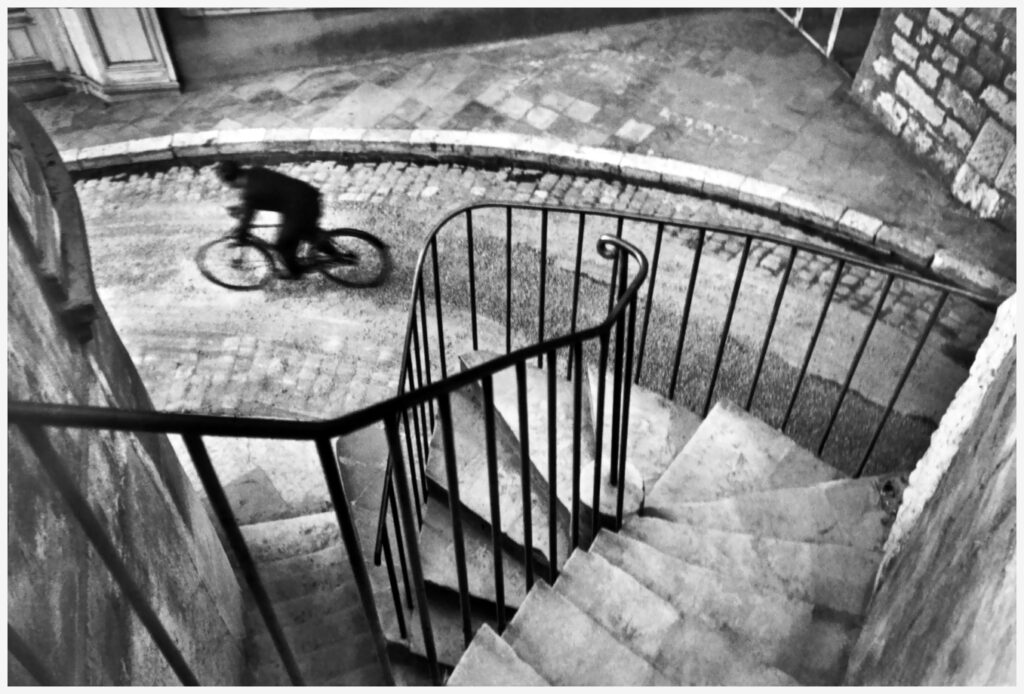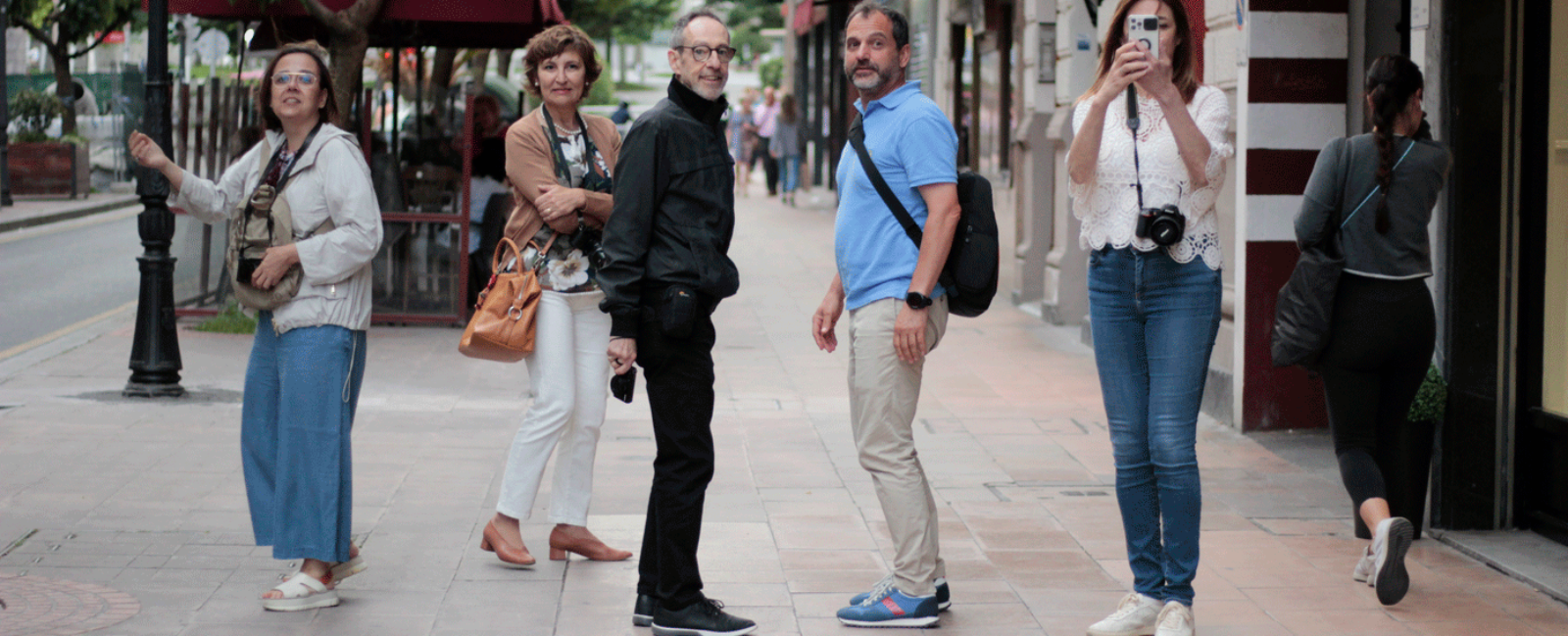

10 Things Henri Cartier-Bresson Can Teach You About Street Photography
Don’t forget to order the new re-print of “The Decisive Moment” by Henri Cartier-Bresson!
I have been doing quite a bit of research into Henri Cartier-Bresson, the godfather of street photography.
Although my current approach in street photography is more like Bruce Gilden and less of Henri Cartier-Bresson, HCB influenced much of my earlier work and I still deeply respect his photography and philosophies. I hope you are able to enjoy these things I believe you can learn from Henri Cartier-Bresson about street photography. Keep reading to become inspired and learn more.
1. Focus on geometry

If you look at the work of Henri Cartier-Bresson, he applied geometry to his images poetically. If you look at the composition of his images he integrated vertical, horizontal, and diagonal lines, curves, shadows, triangles, circles, and squares to his advantage. He also paid particular attention to frames as well.
Don’t only see the world as it is, look for shapes and geometry that occur naturally as well. Open up your mind and break your environment into different formal elements. Look for lines that may lead to your subjects or squares that may frame your image. Become poetic with your images and integrate interesting actors and stages when you are out shooting.
2. Be patient

When Henri Cartier-Bresson would talk about “The Decisive Moment” he said sometimes it would be spontaneous but others times he had to be patient and wait for it. Regardless he was very methodological when he would go out and shoot, and would only keep his images if every element of his image (people, background, framing, and composition) were perfect.
When you are out shooting and you see fascinating scenes, wait for the right person to walk by to complete your image. Although you don’t want to camp out for hours on end to wait for the right moment to occur, practice a bit of patience. You don’t always need to go out and hunt for photo-opportunities. Allow them to come to you.
3. Travel

Henri Cartier-Bresson traveled the world and shot in places such as India, all of Europe, the United States, China, as well as Africa. When he traveled the world, he was able to capture a different slice of life and learn more about the local people he was with. For example when he was shooting in India—he stayed there for around a year and immersed himself into the culture.
Although it is great to shoot street photography in your backyard, it is great to travel as often as you can. Explore different countries and cultures, and it will help inspire your photography and open your eyes.
4. Stick to one lens

Although Henri Cartier-Bresson shot with several different lenses while on-assignment working for Magnum, he would only shoot with a 50mm if he was shooting for himself. By being faithful to that lens for decades, the camera truly became “an extension of his eye”.
Apply the same mentality to when you go out and shoot. I encourage people to use different focal lengths to see the world differently and experiment—but ultimately sticking with one focal length will help you solidify your artistic vision. You will be able to see natural framelines in your everyday life, and know exactly how your photos will appear when shooting from certain angles and distances.
5. Take photos of children

One of my favorite photos by Henri Cartier-Bresson is of this little boy carrying two bottles of wine under his arms, with the triumphant grin of a champion. When I first saw the image, it struck me in the heart as it reminded me of my own childhood. Henri Cartier-Bresson was a master at taking photos of children in their natural playful state, creating images that convey beautiful nostalgia to his viewers.
Nowadays it is incredibly difficult to shoot children (all of this hysteria in the news about pedophilia and kidnappings). However children are great subjects to shoot when it comes to street photography. In my experience I have noticed that they don’t mind being in front of the camera, and often ignore it. Therefore you are able to capture their true essence: playful, curious, and often mischievous.
6. Be unobtrusive

When Henri Cartier-Bresson would shoot on the streets, he would stay as low-key and unobtrusive as he could. I even read that he would cover his chrome Leica in black tape and even sometimes with a hankerchief to make it less noticeable when he was out shooting. Most of the images that he captured his subjects were oblivious of the camera, and thus truly candid.
If you wish to shoot the same way, wear clothes that blend into your environment and work quickly and don’t linger. If you see videos of Henri Cartier-Bresson shooting you can see that he has the dexterity of a feline and is quite agile and quick. If you see a scene you want to capture, quickly bring your camera up to your eye and move on before anybody can notice you.
7. See the world like a painter

Before Henri Cartier-Bresson got into photography, he was actually first interested in painting. Once HCB discovered photography, he applied the same aesthetics in classical painting into his images. For HCB composition was extremely essential, and his images reflect that of romantic painters before him. Interestingly enough when he was much older, he actually denounced photography and focused the rest of his life in drawing. You can check out the interview with him on NPR here.
In order to become a better street photographer, study the work of painters. See how they utilize framing, composition, people, and scenes. One painter that I find absolutely fascinating is Edward Hopper, who was essentially a street photographer armed with a paintbrush. Don’t just limit your inspiration from photography books, explore other forms of classical, modern, surreal, and abstract art as well.
8. Don’t crop
Henri Cartier-Bresson was vehemently opposed to cropping. He believed that whenever you took a photo, it should always be done in-camera. If his framing or composition was a bit off, he would disregard the image.
However, as a caveat, one of his most famous pictures (the jumping man) was cropped— because Henri Cartier-Bresson said he had to shoot it looking through a fence.

Although my philosophy is a bit laxer on cropping, I still believe it is best if you can achieve your street photography without cropping. If you crop too often, you become lazy with your framing when you are actually shooting, which will hinder your photographic vision.
9. Don’t worry about processing

Alicante, Spain
1933
Although Henri-Cartier Bresson knew how to process and develop his own film, he never did it by himself. He would go out and shoot and send his photos to people he trusted, who would develop it for him. This gave him a huge advantage because it would allow how to spend less time in the darkroom, and more time out shooting.
In this modern and digital age, photographers are too concerned about post-processing. If you really know nothing about post-processing, buy a copy of Lightroom 5 and download my free street photography presets. Although I do enjoy post-processing my images from RAW into black and white, spending too much time in post-processing will hinder you. If you shoot a bad photo, no amount of “photoshopping” can improve it.
10. Always strive for more

Henri Cartier-Bresson never had much of an emotional attachment to his images. In the documentary I watched of him, they tried to surprise him by printing and showing him all of his classic and earlier work on the walls of the gallery they were interviewing him at. However, HCB looked at them with little interest and told them that once he took a photo, he would simply move on and look for the next photo.
Although it is great to appreciate your work, never idolize your work and let it hold you back. If you have a great portfolio of images, strive to get even better images. Don’t become satisfied and complacent. Always strive for greatness.
Books by Henri Cartier-Bresson
If you want to learn more about Henri Cartier-Bresson and see more of his inspirational images, purchase one of his books below:
1. “The Decisive Moment“
“The Decisive Moment” was Henri Cartier-Bresson’s first photography book that made a huge splash in the photography world. Was an incredibly rare book, now is being republished for the masses. Don’t miss out!
2. “Scrapbook“

3. “India“

4. “The man, image, & the world“

If you love the work and philosophy of Henri Cartier-Bresson, I recommend reading my newer article on him: “17 (More) Lessons Henri Cartier-Bresson Has Taught Me About Street Photography“
LEARN FROM THE MASTERS OF STREET PHOTOGRAPHY

